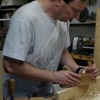Hi-
I'm trying to fix up two older planes and need help on the amount of lapping required. For background, I had good luck bringing an old Stanley #4 back to life, but help from an instructor.
This time I'm on my own with a Union #5 and a Stanley (Baily) #6. The #5 was a local consignment shop find, the #6 purchased at Liberty Tools in Maine on vacation.
My biggest issue is with the #5 (see photo below). I have a good hour into it with 80 grit -- and am making little progress against a big low spot in the back and a somewhat smaller low spot in the front. Also, dip behind the blade is also evident. I've given it a rough run, and it seems to take a noticeably thicker shaving at the end of a board. My goal is a good user, not perfection. Thoughts? (Maybe it's simply a few more hours of elbow grease. Maybe I got a clunker -- luckily it cost next to nothing)
By contrast, the #6 looks pretty good (right pix, sorry about upside down) after several light passes over the 80 grit. (Probably consistent with its much higher price). I think it needs a bit more work to level out the opening -- and then call it quits. Again, thoughts?
As always, advice and counsel much appreciated.
Ken.




 Reply With Quote
Reply With Quote




